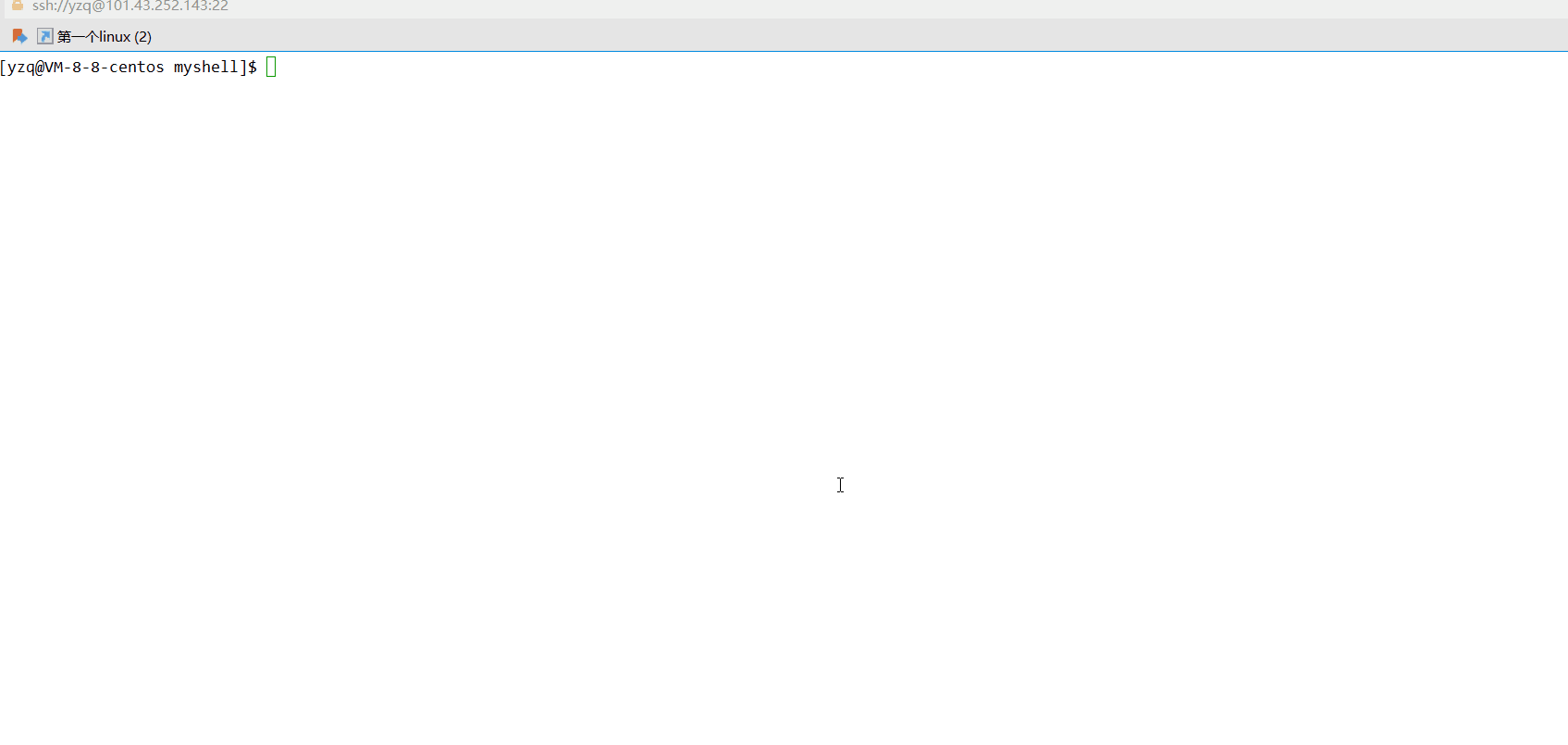- 1程序员接私活的一些平台和建议,千万要注意,别掉坑里!_开源众包
- 2dubboreference注解_dubbo学习篇1 注解之 @Reference 原理解析
- 3解压你的压缩:Python ZipFile 实战指南(一)ZipFile 类和它的参数们
- 4node.js 安装详细步骤教程_nodeis
- 5常用排序算法的时间复杂度一览_排序算法时间复杂度
- 6《Kubernetes网络权威指南》读书笔记 | Pod的核心:pause容器_pod pause
- 7Python中List、Array数组的拼接、合并_python list 和array拼
- 8python重庆酒店宾馆数据可视化大屏全屏系统设计与实现(django框架)_酒店python可视化分析
- 9软考算法-算法篇_软考常考的算法
- 10常用的pip源
【Linux】进程的程序替换_linux 程序如何替换自己
赞
踩
1. 程序替换
1.创建子进程的目的是什么?
目标:为了让子进程帮父进程执行特定的任务
- 具体做法:1. 让子进程执行父进程的一部分代码
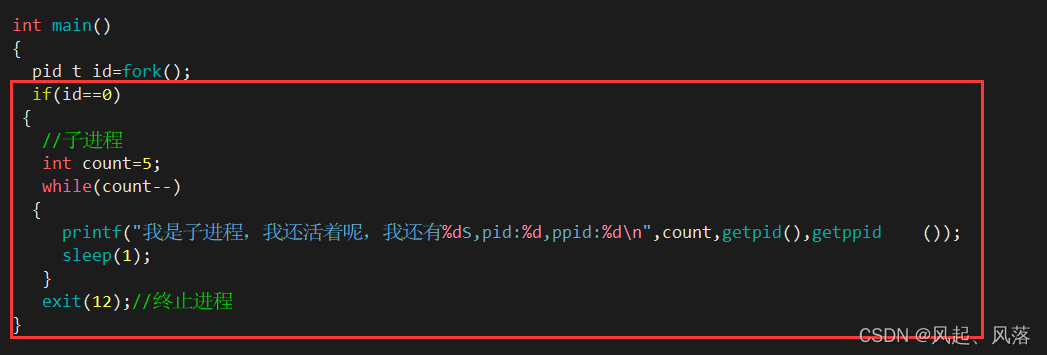
红框中的代码实际上是父进程的代码,在没有执行fork之前代码就有了,在没有创建子进程之前,父进程的代码加载到内存了,子进程被创建出来是没有独立的代码,这个代码是父进程的代码,父进程通过if判断分流让子进程去跑了
- 2.创建一个子进程不执行父进程的代码,而是让子进程在磁盘当中执行全新的程序,这种操作称之为进程的程序替换
2.了解程序是如何进行替换的
程序替换函数 execl
输入 man execl 查看程序替换接口
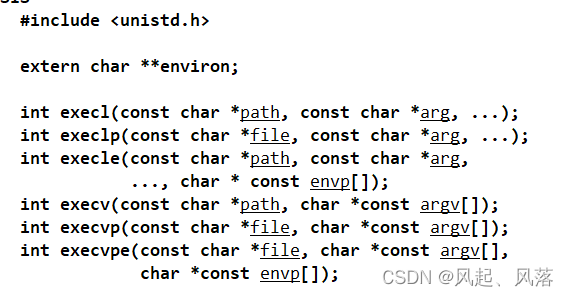
int execl(const char *path, const char *arg, …);
括号内部的 . . . 称为 可变参数列表,可以给c函数传递任意个数的参数
第一个参数为 要执行什么命令
第二个参数 为 要怎样执行程序
最后以NULL结尾表示参数传完了
创建test.c文件并输入以下内容
#include<stdio.h> #include<stdlib.h> #include<unistd.h> int main() { printf("begin......\n"); printf("begin......\n"); printf("begin......\n"); printf("begin......\n"); execl("/bin/ls", "ls", "-a", "-l", NULL); printf("end........\n"); printf("end........\n"); printf("end........\n"); printf("end........\n"); }
- 1
- 2
- 3
- 4
- 5
- 6
- 7
- 8
- 9
- 10
- 11
- 12
- 13
- 14
- 15
- 16
- 17
- 18
- 19
运行可执行程序发现,只有begin 以及执行 ls -l -a显示的指令

再次修改test.c文件内容如下
#include<stdio.h> #include<stdlib.h> #include<unistd.h> int main() { printf("begin......\n"); printf("begin......\n"); printf("begin......\n"); printf("begin......\n"); printf("我已经是一个进程啦,我的PID:%d\n",getpid()); execl("/bin/ls", "ls", "-a", "-l", NULL); printf("end........\n"); printf("end........\n"); printf("end........\n"); printf("end........\n"); }
- 1
- 2
- 3
- 4
- 5
- 6
- 7
- 8
- 9
- 10
- 11
- 12
- 13
- 14
- 15
- 16
- 17
- 18
- 19
- 20
test.c 经过编译形成mytest可执行程序,./可执行程序就变成进程了,CPU调度进程 ,打印出代码中的打印语句,同时调用程序替换execl,将ls程序执行起来了
[yzq@VM-8-8-centos nn]$ file /bin/ls
/bin/ls: ELF 64-bit LSB executable, x86-64, version 1 (SYSV), dynamically linked (uses shared libs), for GNU/Linux 2.6.32, BuildID[sha1]=c8ada1f7095f6b2bb7ddc848e088c2d615c3743e, stripped
- 1
- 2
- 3
使用的 /bin/ls 命令 实际上是一个可执行程序,所以ls程序是在磁盘上的
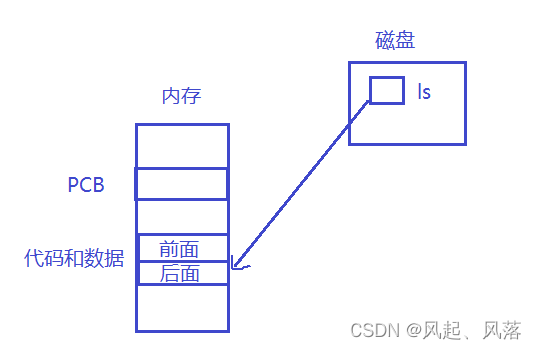
前面执行的是自己代码的一部分,当调用execl时,将磁盘中可执行程序替换当前进程的代码和数据
后半部分就不执行自己的代码了,执行ls所对应的代码 ,这个现象就叫做程序替换
程序替换就是让一个进程去执行另一个在磁盘中的程序,让一个进程把一个新的程序运行起来
3. 程序替换的基本原理
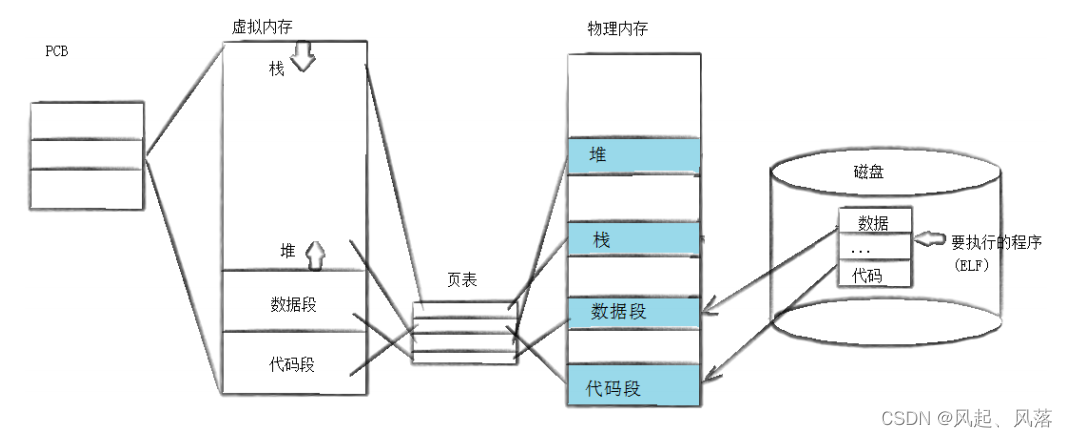
当前的进程执行当前代码时,如果执行了函数execl等接口,就会根据你所传入的程序的路径以及你要执行的名称及选项,把磁盘当中的一个其他的程序加载到对应的内存,
用新程序的代码替换当前进程的代码段,用当前进程的数据替换老进程的数据段
站在进程的角度
进程的程序替换有没有创建新的进程呢?
没有,只是将新的程序加载到当前进程的代码段和数据段,用CPU去调度当前进程就可以跑起来了
站在程序的角度
程序被加载了内存中,就可以称程序替换的接口(execl) 为加载器
当创建进程的时候,先有进程数据结构,还是先加载代码和数据?
修改test.c文件为以下内容
#include<stdio.h>
2 #include<stdlib.h>
3 #include<unistd.h>
4 int main()
5 {
6 execl("/bin/ls", "ls", "-a", "-l", NULL); 7 }
- 1
- 2
- 3
- 4
- 5
- 6
- 7
此时运行可执行程序,自己就写了一个ls命令

创建子进程,让子进程调用execl,在调用execl把代码和数据加载到内存
所以当创建进程的时候,先有进程数据结构,再加载代码和数据
程序替换是整体替换,不是局部替换
修改test.c文件内容如下
#include<stdio.h> 2 #include<stdlib.h> 3 #include<unistd.h> 4 #include<sys/wait.h> 5 int main() 6 { 7 pid_t id=fork(); 8 if(id==0) 9 { 10 //child 11 printf("我是子进程:%d\n",getpid()); 12 execl("/bin/ls", "ls", "-a", "-l", NULL); 13 } sleep(5); 14 printf("我是父进程:%d\n",getpid()); 15 waitpid(id,NULL,0); 16 }
- 1
- 2
- 3
- 4
- 5
- 6
- 7
- 8
- 9
- 10
- 11
- 12
- 13
- 14
- 15
- 16
- 17
查看子进程完成替换后会不会影响父进程,如果影响父进程,就不应该打印父进程的这句话了
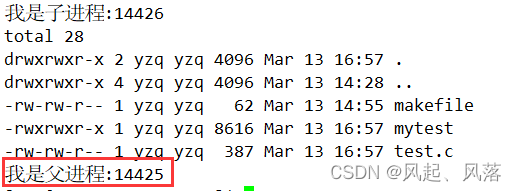
过了5秒钟,父进程结果打印出来,说明父进程不受子进程影响
程序替换只会影响调用进程,进程具有独立性
父子进程都有自己独立的PCB 地址空间 页表 也会自己的映射关系
虽然代码有可能是跟父进程共享,当子进程进行程序替换的时候,子进程会加载新进程的代码和数据
操作系统会发生写时拷贝,将代码和数据进行区分 ,使子进程形成新的映射关系,从而使子进程不会影响到父进程
execl 返回值
如果出错了,execl返回值为-1
修改test.c文件内容如下
#include<stdio.h> 2 #include<stdlib.h> 3 #include<unistd.h> 4 #include<sys/wait.h> 5 int main() 6 { 7 pid_t id=fork(); 8 if(id==0) 9 { 10 //child 11 printf("我是子进程:%d\n",getpid()); 12 int n=execl("/bin/lsss", "lsss", "-a", "-l", NULL);//lsss命令不存在 13 printf("you can see me:%d\n",n); 14 exit(0); 15 } 16 sleep(5); 17 printf("我是父进程:%d\n",getpid()); 18 waitpid(id,NULL,0); 19 } 20
- 1
- 2
- 3
- 4
- 5
- 6
- 7
- 8
- 9
- 10
- 11
- 12
- 13
- 14
- 15
- 16
- 17
- 18
- 19
- 20
输入的lsss命令不存在,查询报错后的execl的返回值

程序替换只要成功,就会跑去执行新程序,失败了就会继续向后运行
所以execl程序替换成功不会有返回值——>如果替换失败,一定有返回值——>如果失败了,必定返回——>只要有返回值就失败了
说明不用对execl函数的返回值进行判断,只要继续向后运行一定失败
4. 替换函数
1. execl
int execl(const char *path, const char *arg, …);
l 代表 list 链表
path:代表你想执行谁 (需要带路径)
执行一个程序最基本的原则为:找到它,加载执行它
arg:你想怎么执行它(若想执行ls指令,是只执行ls,还是执行ls- l 、ls -l -a指令
在命令行怎么执行这个命令,就把参数一个一个的传递给execl就可以了
最终以NULL结尾
具体的实现以及返回值问题上面在演示程序替换时已经使用过啦
2. execv
int execv(const char *path, char *const argv[]);
v代表vector 容器
path:代表你想执行谁 (需要带路径)
把原来需要一个一个传的参数放在argv[]数组中
修改test.c文件内容
1 #include<stdio.h> 2 #include<stdlib.h> 3 #include<unistd.h> 4 #include<sys/wait.h> 5 int main() 6 { 7 pid_t id=fork(); 8 if(id==0) 9 { 10 //child 11 printf("我是子进程:%d\n",getpid()); 12 char *const myargv[]={"ls", "-l", "-a",NULL}; 13 execv("/bin/ls",myargv); 14 exit(0); 15 } 16 sleep(5); 17 printf("我是父进程:%d\n",getpid()); 18 waitpid(id,NULL,0); 19 } 20
- 1
- 2
- 3
- 4
- 5
- 6
- 7
- 8
- 9
- 10
- 11
- 12
- 13
- 14
- 15
- 16
- 17
- 18
- 19
- 20
- 21
- 22
执行可执行程序,依旧可以执行ls指令
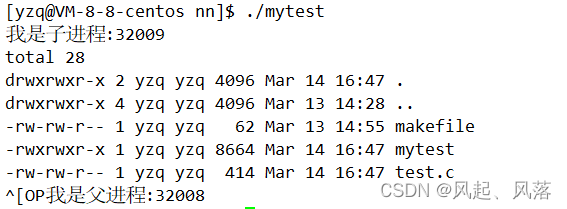
3. execlp
int execlp(const char *file, const char *arg, …);
带p:代表当执行程序的时候,只需要指定程序名即可,系统会自动在PATH环境变量中查找
file: 不需要传路径,只需要把在PATH环境变量的指令传过来
最后以NULL结尾
#include<stdio.h> 2 #include<stdlib.h> 3 #include<unistd.h> 4 #include<sys/wait.h> 5 int main() 6 { 7 pid_t id=fork(); 8 if(id==0) 9 { 10 //child 11 printf("我是子进程:%d\n",getpid()); 12 execlp("ls", "ls", "-l", "-a",NULL); 13 exit(0); 14 } 15 sleep(5); 16 printf("我是父进程:%d\n",getpid()); 17 waitpid(id,NULL,0); 18 }
- 1
- 2
- 3
- 4
- 5
- 6
- 7
- 8
- 9
- 10
- 11
- 12
- 13
- 14
- 15
- 16
- 17
- 18
执行可执行程序,依旧可以执行ls指令

4. execvp
int execvp(const char *file, char *const argv[]);
带p:代表当执行程序的时候,只需要指定程序名即可,系统会自动在PATH环境变量中查找
v代表vector 容器
#include<stdio.h> #include<stdlib.h> #include<unistd.h> #include<sys/wait.h> int main() { pid_t id=fork(); if(id==0) { //child printf("我是子进程:%d\n",getpid()); char* const myargv[]={"ls", "-l", "-a",NULL}; execvp("ls", myargv); exit(0); } sleep(5); printf("我是父进程:%d\n",getpid()); waitpid(id,NULL,0); }
- 1
- 2
- 3
- 4
- 5
- 6
- 7
- 8
- 9
- 10
- 11
- 12
- 13
- 14
- 15
- 16
- 17
- 18
- 19
- 20
- 21

5. execle
int execle(const char *path, const char *arg,
…, char * const envp[]);
path:代表你想执行谁 (需要带路径)
envp[]:代表自定义环境变量
如果调用程序替换时,若不想让子进程使用父进程的环境列表,想自定义环境变量,就可以自己传一个环境变量
在另一个目录中创建other.cc (以cc为结尾说明是一个c++程序),并输入以下内容
#include <iostream> #include <unistd.h> #include<stdlib.h> using namespace std; int main() { for(int i = 0; i < 5; i++) { cout<< "我是另一个程序,我的pid是:"<< getpid()<<endl; cout << " MYENV: " << (getenv("MYENV")==NULL?"NULL":getenv("MYENV")) << endl; sleep(1); } return 0; }
- 1
- 2
- 3
- 4
- 5
- 6
- 7
- 8
- 9
- 10
- 11
- 12
- 13
- 14
- 15
- 16
修改test.c文件为以下内容
#include<stdio.h> #include<stdlib.h> #include<unistd.h> #include<sys/wait.h> int main() { pid_t id=fork(); if(id==0) { //child printf("我是子进程:%d\n",getpid()); W> char*const myenv[]={"MYENV=YouCanSeeMe", NULL}; execle("/home/mydir/my/mm/myother", "myother", NULL,myenv); exit(0); } sleep(1); printf("我是父进程:%d\n",getpid()); int status=0; waitpid(id,&status,0); return 0; }
- 1
- 2
- 3
- 4
- 5
- 6
- 7
- 8
- 9
- 10
- 11
- 12
- 13
- 14
- 15
- 16
- 17
- 18
- 19
- 20
- 21
- 22

第一个路径为other.cc生成的可执行程序 myother 所在的 绝对路径

2. 自定义shell
编写极简版本的shell(bash)
目标:为了深刻的理解shell的运行原理
输入 ps ajx |grep bash ,发现bash就是一个进程

由于shell是一个进程,所以用while死循环
缓冲区问题

正常来说,运行可执行程序会显示命令行,但是由于没有\n刷新缓冲区,也没有使用相关的刷新库函数,所以命令行会一直在缓冲区中 直到 程序结束才显示,但是这是个死循环,所以什么都不会显示


执行可执行程序后即可显示命令行
fgets 使用出现空格问题
fgets 标准输入 按行获取
char *fgets(char *s, int size, FILE *stream);
从特定的标准输入当中获取对应的命令行输入,把对应的数据放在缓冲区中
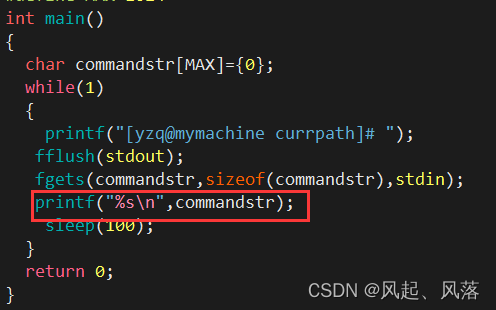

执行可执行程序后,发现在命令行中输入 ls -a ,就会打印出 ls -a,但是输入时会多出一个空行

正常来说,都会使用回车来到下一行,而这个回车被fgets读取到了

将最后的回车符替换成’\0’

此时就没有空格出现了
完整代码
: mybash.c ? ? ?? buffers #include<stdio.h> #include<unistd.h> #include<string.h> #include<assert.h> #include<sys/types.h> #include<sys/wait.h> #include<stdlib.h> #define MAX 1024 #define ARGC 64 #define SEP " " int split (char*commandstr,char*argv[]) { assert(commandstr); assert(argv); argv[0]=strtok(commandstr,SEP);//在commandstr以空格作为分割符 if(argv[0]==NULL)//切割失败 { return -1; } int i=1; while(1) { argv[i]=strtok(NULL,SEP);//继续切割空格 if(argv[i]==NULL) { break; } i++; } W>} void print(char*argv[]) { int i=0; for(i=0;argv[i];i++) { printf("%d:%s\n",i,argv[i]); } } int main() { while(1) { char commandstr[MAX]={0}; char*argv[ARGC]={NULL}; printf("[yzq@mymachine currpath]# "); fflush(stdout); char*s= fgets(commandstr,sizeof(commandstr),stdin); assert(s); (void)s;//保证在release方式发布的时候,因为去掉assert了,所以s就没有被使用,而带来的编译告警, 什么都没做,但是充当一次使用 commandstr[strlen(commandstr)-1]='\0';//将最后的回车符用'\0'覆盖掉 int n= split(commandstr,argv); //从命令行中获取的字符串传入argv中 if(n!=0) continue;//切割失败就什么都不做 // print(argv);//打印字符串 pid_t id=fork(); assert(id>=0); (void)id; if(id==0) { //child execvp(argv[0],argv); exit(1); } int status=0; waitpid(id,&status,0); } }
- 1
- 2
- 3
- 4
- 5
- 6
- 7
- 8
- 9
- 10
- 11
- 12
- 13
- 14
- 15
- 16
- 17
- 18
- 19
- 20
- 21
- 22
- 23
- 24
- 25
- 26
- 27
- 28
- 29
- 30
- 31
- 32
- 33
- 34
- 35
- 36
- 37
- 38
- 39
- 40
- 41
- 42
- 43
- 44
- 45
- 46
- 47
- 48
- 49
- 50
- 51
- 52
- 53
- 54
- 55
- 56
- 57
- 58
- 59
- 60
- 61
- 62
- 63
- 64
- 65
- 66
- 67
- 68
- 69
- 70
动图演示
